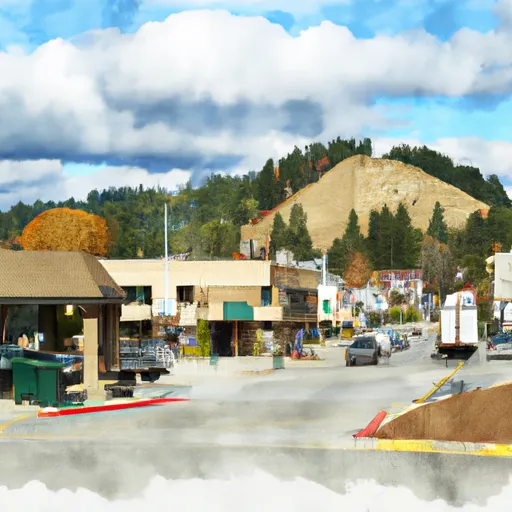-
 Snoflo Premium
Snoflo Premium
Get unlimited access to all our content
With no Ad interruptions! - Start Your Free Trial Login with existing account
Mineral
Eden Index
Climate
7.3
•
Recreation
1.4
•
Community
•
Safeguard
3.4/10

Mineral, Washington is a small town located in Lewis County, nestled in the beautiful Cascade Mountains region of the Pacific Northwest. The town experiences a temperate, marine-influenced climate, characterized by mild summers and cool, wet winters. The average annual rainfall reaches around 100 inches, ensuring lush green landscapes and a diverse hydrology system.
Mineral is surrounded by stunning natural surroundings, including forests, rivers, and mountains, making it an ideal destination for outdoor enthusiasts. The nearby Gifford Pinchot National Forest offers various recreational opportunities such as hiking, mountain biking, fishing, and camping. The region is also known for its numerous lakes, including Lake Scanewa and Mineral Lake, offering opportunities for boating, swimming, and fishing.
For adventure seekers, Mount Rainier National Park is just a short drive away, providing opportunities for mountaineering, skiing, and snowboarding. The park also features breathtaking glaciers, meadows, and waterfalls, attracting hikers and nature lovers.
In conclusion, Mineral, Washington boasts a pleasant climate, diverse hydrology constituents, and abundant outdoor recreation opportunities. Whether you're looking for leisurely activities or thrilling adventures, this charming town is sure to captivate nature enthusiasts of all kinds.
What is the Eden Index?
The Snoflo Eden Index serves as a comprehensive rating system for regions, evaluating their desirability through a holistic assessment of climate health, outdoor recreation opportunities, and natural disaster risk, acknowledging the profound impact of these factors on livability and well-being.
Climate Health Indicator (CHI): 7.3
Mineral receives approximately
1820mm of rain per year,
with humidity levels near 65%
and air temperatures averaging around
9°C.
Mineral has a plant hardyness factor of
8, meaning
plants and agriculture in this region tend to thrive here all year round.
By considering the ideal temperature range, reliable water supplies, clean air, and stable seasonal rain or snowpacks, the Climate Health Indicator (CHI) underscores the significance of a healthy climate as the foundation for quality living.
A healthy climate is paramount for ensuring a high quality of life and livability in a region, fostering both physical well-being and environmental harmony. This can be characterized by ideal temperatures, reliable access to water supplies, clean air, and consistent seasonal rain or snowpacks.
Weather Forecast
Streamflow Conditions
Puget Sound
Area Rivers
Puget Sound
Snowpack Depths
Puget Sound
Reservoir Storage Capacity
Puget Sound
Groundwater Levels
Recreational Opportunity Index (ROI): 1.4
The Recreational Opportunity Index (ROI) recognizes the value of outdoor recreational options, such as parks, hiking trails, camping sites, and fishing spots, while acknowledging that climate plays a pivotal role in ensuring the comfort and consistency of these experiences.
Access to outdoor recreational opportunities, encompassing activities such as parks, hiking, camping, and fishing, is crucial for overall well-being, and the climate plays a pivotal role in enabling and enhancing these experiences, ensuring that individuals can engage in nature-based activities comfortably and consistently.
Camping Areas
| Campground | Campsites | Reservations | Toilets | Showers | Elevation |
|---|---|---|---|---|---|
| Mowich Lake - Mount Rainier National Park | 30 | 4,935 ft | |||
| Rocky Point - Alder Lake | 25 | 1,234 ft | |||
| Taidnapam Park - Tacoma Power | 183 | 804 ft | |||
| Ipsut Creek - Mount Rainier National Park | 12 | 2,339 ft |
Nearby Ski Areas
Catastrophe Safeguard Index (CSI):
The Catastrophe Safeguard Index (CSI) recognizes that natural disaster risk, encompassing floods, fires, hurricanes, and tornadoes, can drastically affect safety and the overall appeal of an area.
The level of natural disaster risk in a region significantly affects safety and the overall livability, with climate change amplifying these risks by potentially increasing the frequency and intensity of events like floods, fires, hurricanes, and tornadoes, thereby posing substantial challenges to community resilience and well-being.
Community Resilience Indicator (CRI):
The Community Resilience Indicator (CRI) recognizes that education, healthcare, and socioeconomics are crucial to the well-being of a region. The CRI acknowledges the profound impact of these elements on residents' overall quality of life. By evaluating educational resources, healthcare accessibility, and economic inclusivity, the index captures the essential aspects that contribute to a thriving community, fostering resident satisfaction, equity, and social cohesion.

